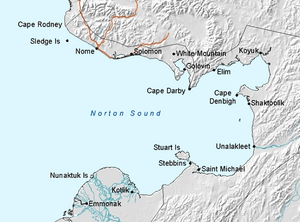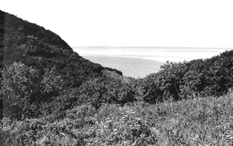Norton Bay facts for kids
Norton Bay is a large bay in Alaska, a state in the United States. It's found on the northeastern side of Norton Sound, which is part of the Bering Sea. The bay is also located on the Seward Peninsula. Several rivers, like the Kwik, Kwiniuk, and Tubutulik rivers, flow into Norton Bay. In the Inupiat language, it's called Kaŋiiqusuk.
Contents
How Norton Bay Got Its Name
Captain James Cook first explored this area in 1778. He named both Norton Bay and Norton Sound after Sir Fletcher Norton. Sir Norton was an important person in the British government at the time. He was the speaker of the House of Commons of Great Britain. The name "Norton" was officially given to the bay in 1859 by the Coast Survey.
Exploring Norton Bay's Geography
Norton Bay is surrounded by interesting land features. On its northern side, you can see the Kwiktalik Mountain, which is about 1,200 feet tall. The Reindeer Hills are located on the southern side of the bay. Cape Nome is right at the entrance to the bay.
Around 1902, there were a few Alaska Native villages along the northern shore. These included the villages of Kviguk and Kwik. Rivers like the Kvingak, Kwik, and Kwiniuk flow into the bay from the north. The Tubutulik River also joins the bay; its name was given by Temenkof in 1849. Captain Mikhail Dmitrievich Tebenkov visited Norton Sound in 1831. He was a director of the Russian American Company and governor of Russian America from 1845 to 1850.
Finding Gold in Norton Bay
You might wonder if there's gold in Norton Bay! There are some small amounts of placer gold in the Nulato-Norton Bay area. Placer gold is gold found in loose sand or gravel. It's not as much as in the Nome area, but it's still there.
Some of the rivers that flow into the bay, like the Kwiniuk, Tubutulik, and Kwik rivers, have placer gold. This means that the gold can also be carried by the water into the bay itself.
Animals Living in Norton Bay
The waters of Norton Bay are home to many animals. These animals have been an important food source for the people living in the area for a long time. You can find small fish like tomcod and herring here.
Different types of seals also live in the bay. The hair from seals was used to make fur cloth. The tough skin of the ogruk, a type of thick-skinned seal, was used to make special footwear called mukluks for the local people. In the spring, walrus are also found in the bay, and they are caught for food.
Important Places and Landmarks
One very important place is the Iyatayet Site. It's a National Historic Landmark located on the northwest shore of Cape Denbigh, right on Norton Bay. This site is special because it shows us about the ancient Norton Culture. This culture existed between 500 BC and 300 AD.
Scientists have found layers of old tools and other items here. Below the Norton Culture layers, they found even older items from the Denbigh Flint Complex, dating back to 6000-4000 BC. These discoveries help us understand how people lived and how cultures developed over thousands of years, connecting to the Paleolithic and Mesolithic ages.
In 1840, a fort and a trading town were built at the mouth of the Ukaliik River, which is part of Norton Bay. This town was also named after the river.
Protecting Nature: Norton Bay Nature Reserve
The Norton Bay Nature Reserve was created in 1917. It's a huge area, covering about 350,000 acres! This reserve was set aside for the use of the US Bureau of Education and the Indigenous Alaskan people.
The reserve stretches for about 110 miles southeast of Nome and covers the coastal area of Norton Bay. This area is also important because it contains the burial grounds of many Eskimo natives who sadly died from epidemic diseases a long time ago.



